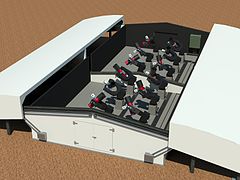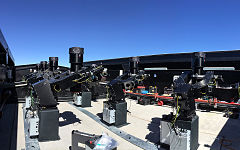Next-Generation Transit Survey
| Next-Generation Transit Survey | |
|---|---|
 | |
| Observatoř | Observatoř Paranal |
| Místo | Region Antofagasta |
| Oblast | Atacama |
| Stát | Chile |
| Souřadnice | 24°36′57″ j. š., 70°23′28″ z. d. |
| Nadmořská výška | 2 443 m n. m. |
| První světlo | 2015 |
| Průměr | 0,2 m |
| Počet | 12 stejných dalekohledů |
| Commons | Next-Generation Transit Survey |
| Některá data mohou pocházet z datové položky. | |
Next-Generation Transit Survey (NGTS) je soustava 12 malých velmi citlivých dalekohledů pro hledání exoplanet. Nachází se na Observatoři Paranal v Chile v nadmořské výšce 2 443 m n. m. Systém je určen k hledání exoplanet střední velikosti – od tzv. superzemí po plynné obry o velikosti Neptunu.
Přestože je NGTS umístěn na Observatoři Paranal Evropské jižní observatoře, není jí řízen. Je pod správou sdružení sedmi univerzit a výzkumných zařízení z Německa, Velké Británie, Švýcarska a Chile (University of Warwick, Německé středisko pro letectví a kosmonautiku, Universidad de Chile a další).[1]
Popis
Systém se skládá z 12 robotických dalekohledů o průměru zrcadla 0,2 m.[2] Každý z dalekohledů má zorné pole 8 čtverečních stupňů a celá soustava tedy téměř 96 čtverečních stupňů, což je mnohem více než jiné astronomické dalekohledy. Používá CCD kamer citlivých na viditelné červené a blízké infračervené světlo (600–900 nm).
Dalekohledy NGTS se nachází na Observatoři Paranal 2 km severovýchodně od hlavních přístrojů této observatoře – dalekohledů VLT (Very Large Telescope). Všechny se nacházejí v jedné budově s odsouvatelnou střechou a jsou plně ovladatelné na dálku.
Historie
Systém vychází obdobně konstruovaného systému WASP (respektive SuperWASP), používá však vylepšený software, větší dalekohledy a detektory citlivější na malé změny jasu sledovaných hvězd. Jeho prototypy byly zkoušeny v letech 2009–2010 na Roque de los Muchachos Observatory na ostrově La Palma na Kanárských ostrovech,[3] později v letech 2012–2014 na Ženevské observatoři. Pracuje od začátku roku 2015, kdy jím prošlo tzv. první světlo, plně funkční je od ledna 2016.[4]
Objevy
První extrasolární planetou objevenou tímto zařízením je NGTS-1b – planeta typu horký Jupiter, která obíhá kolem červeného trpaslíka jednou za 2,65 dne.[2] Nachází se v Souhvězdí Holubice přibližně 600 světelných let od Země.
Odkazy
Reference
- ↑ NGTS Partner Institutes [online]. Next-Generation Transit Survey, 2017 [cit. 2017-11-25]. Dostupné v archivu pořízeném dne 2017-12-02.
- ↑ a b MARTÍNEK, František. Obří exoplaneta, která by podle současných teorií neměla existovat. astro.cz. Česká astronomická společnost, 2017-11-07. Dostupné online [cit. 2017-11-25].
- ↑ The NGTS Prototype [online]. Next-Generation Transit Survey, 2017 [cit. 2017-11-25]. Dostupné v archivu pořízeném dne 2017-12-07.
- ↑ The Next-Generation Transit Survey — Paranal’s planet-hunting array [online]. Evropská jižní observatoř, 2016 [cit. 2017-11-25]. Dostupné online.
Související články
- WASP (astronomie)
Externí odkazy
 Obrázky, zvuky či videa k tématu Next-Generation Transit Survey na Wikimedia Commons
Obrázky, zvuky či videa k tématu Next-Generation Transit Survey na Wikimedia Commons - Stránky projektu
Média použitá na této stránce
Autor: ESO/R. West, Licence: CC BY 4.0
The Next-Generation Transit Survey (NGTS) is located at ESO's Paranal Observatory in northern Chile. This project will search for transiting exoplanets — planets that pass in front of their parent star and hence produce a slight dimming of the star's light that can be detected by sensitive instruments. The telescopes will focus on discovering Neptune-sized and smaller planets, with diameters between two and eight times that of Earth. This engineering rendering shows the complete system in its enclosure.
Autor: ESO/R. West, Licence: CC BY 4.0
The Next-Generation Transit Survey (NGTS) is located at ESO's Paranal Observatory in northern Chile. This project will search for transiting exoplanets — planets that pass in front of their parent star and hence produce a slight dimming of the star's light that can be detected by sensitive instruments. The telescopes will focus on discovering Neptune-sized and smaller planets, with diameters between two and eight times that of Earth. This engineering rendering shows the complete system in its enclosure.
Autor: ESO/R. West, Licence: CC BY 4.0
The Next-Generation Transit Survey (NGTS) is located at ESO's Paranal Observatory in northern Chile. This project will search for transiting exoplanets — planets that pass in front of their parent star and hence produce a slight dimming of the star's light that can be detected by sensitive instruments. The telescopes will focus on discovering Neptune-sized and smaller planets, with diameters between two and eight times that of Earth. Most of the 20-centimetre telescopes that form the survey system are shown in this picture taken during testing.




